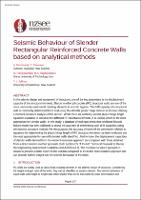Seismic Behaviour of Slender Rectangular Reinforced Concrete Walls based on analytical methods

Download
Date
2023-04-19Authors
Niroomandi, Arsalan
Stevenson, Craig
Najafgholipour, Mohammad Amir
Firoozbakhtian, Mahshid
Sullivan, Tim
Metadata
Show full item recordAbstract
In the seismic design and assessment of structures, one of the key parameters is the displacement capacity of the structural elements. Slender reinforced concrete (RC) structural walls are one of the more commonly used lateral resisting elements in seismic regions. The drift capacity of a structural wall is commonly determined from evaluating the ultimate plastic hinge rotation at its base utilising a moment-curvature analysis of the section. While there are currently several plastic hinge length equations available in literature for different RC structural elements, it is unclear which is the most appropriate for slender walls. In this study, a database of wall specimens that exhibited failure modes that can be predicted by a moment-curvature analysis, such as concrete crushing, bar yielding, and rupture, is collected to assess the accuracy of this method. For this purpose, the accuracy of some of the commonly referred equations for determining the plastic hinge length of RC structural elements have been evaluated and the most suitable one appropriate for use with slender walls identified. Moreover, the accuracy of results from moment-curvature analyses is compared with those obtained from direct rotation methods (both Section C5 and ASCE41-17) for determining the displacement capacity of slender walls. It is shown that moment-curvature analysis has reasonable accuracy compared to direction rotation methods and can provide further insight into the seismic behaviour of the wall.
